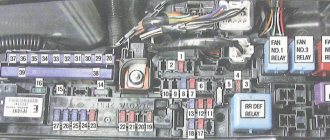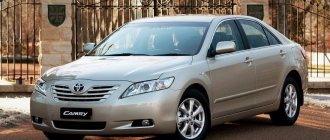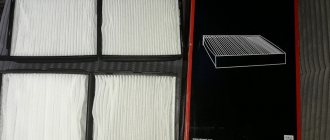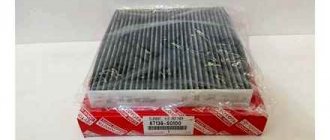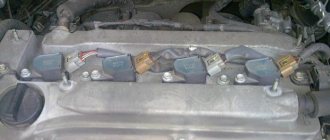The Toyota Camry XV30 sedan was produced from mid-2001 to 2006. It attracted buyers with its reliability, comfort, good equipment and solidity. The European consumer did not appreciate the advantages of this model, preferring the Toyota Avensis to it. In North America, Japan and the CIS countries, thirty became a real bestseller. In our country, the thirtieth body, despite its considerable age, is still an attractive car worthy of attention.
Camry XV30 before restyling
Body and appearance
Thirty after restyling
The appearance is the personification of American automotive design of those years, which was characterized by smooth lines, rounded shapes and the obligatory presence of chrome on the radiator grille. The appearance of the 5th generation Camry fully corresponds to the philosophy of a comfortable, respectable business class car. Compared to the previous generation (XV 20), the body has significantly increased in size: in length by 50 mm, in height by 70 mm, and in width by 10 mm.
The Camry in the 30th body is made of excellent metal: even if the car is all covered with small chips, you are unlikely to find rust on it.
The only place where “bugs” can appear is the trunk lid near the chrome trim. In 2005, the car underwent minor restyling: the radiator grille and front bumper changed, and different headlights and taillights began to be installed.
I drove the vibrating car for a long time until I went for diagnostics, where they told me for sure that it was an internal grenade in the right drive. How I looked for a replacement is a different story. And judging by the drive and the core, all the drives broke down at the same time. As a result, I ordered through one office directly from Japan, at a price of 6,000 and with a 45-day delivery period. There was no choice, I made an advance payment (at the beginning of August) - and now I waited.
How I looked for a replacement is a different story. And judging by the drive and the core, all the drives broke down at the same time. As a result, I ordered through one office directly from Japan, at a price of 6,000 and with a 45-day delivery period. There was no choice, I made an advance payment (at the beginning of August) - and now I waited.
6 sput and 45 working days of waiting - and it’s mine!
The feeling is as if the donor car in Japan came off the production line, sat there, had the drive removed and sent to me. If its condition is as good as its appearance, I won’t regret overpaying.
Like New. Only bushy
Where do they come from?
Ok, time to change. How to say “fucked up” without swearing? In general, there are not many photos, I only took photos of the main points, because until I installed a new one, I was not sure that I was doing everything correctly. And this is exhausting.
Let's get started. I won’t describe how to remove a wheel or unscrew a brake caliper. Hang the caliper by a wire to the strut spring so that it does not hang on the brake hose. Now you need to move the hub to the side. Unscrew the strut from the hub, unscrew the hub from the lever (next two photos)
Unscrew the rack - two 22 nuts, you will need two keys
Unscrew the hub from the lever
Turn the steering wheel to the left so that the tie rod does not interfere with moving the hub as far as possible from the drive. Then it won’t be very convenient - the hub is a bit heavy, and there’s also a disk on it, and the drive will get in the way while it’s in the hub. But there shouldn't be any problems.
Yes, it will be easier if you also lift the left side of the car so that the lever on the stabilizer goes down.
This will be enough
Unscrew the cross ski and remove it from the car so that it does not get under your feet with your hands.
Unscrew the cross ski
When you unscrew the ski, drain the oil from the differential. Although it seems to me that the filler plug is at the same level with the “hole” of the drive, so when we pull out the drive, it won’t pour on my face, but personally I don’t regret that I drained it, because now I’m sure that the differential has the right amount of fresh ATP.
Next I forgot to take a photo: you need to unscrew the muffler pipe. Two nuts approximately under the selector. In the previous photo you can see them behind the ski. We do this so that the pipe can be moved to the sides by unscrewing the suspension bearing bracket. The pipe hangs on a corrugation, so it moves almost without problems 
When unscrewing the bracket, you will need a cardan joint, because the head extension will not fit there at a right angle.
Unscrew the suspension bearing bracket
All you have to do is pull the drive towards you and it will gently come out of the box. Well, that’s exactly what happened to me.
If you have completed this far, then reassembling should not cause problems without any reports, but your humble servant still encountered one difficulty - pouring it back into the differential. The filler plug should fit a regular head, but mine turned out to be round - someone tore off the edges. I won’t tell you how I suffered with her, in fact, more than half of the curses were because of her, but here I’ll go straight to the finale: I went and bought a gas wrench with sharp teeth on the jaws. I didn’t take a photo, but the gas one unscrewed it right away, I even cursed myself for wasting time, effort and a chisel, and didn’t go and buy a key right away. Well, okay, I wish I knew where to fall.
Filling the slurry was also a big deal - all the hoses that went into the filler plug turned out to be just a tube from a dropper, and about a liter and a half of ATP went in. One and a half liters through the IV tube is not that long, but enough to strengthen the feeling of being ass-handed.
But when I tightened the filler plug (the old one, there was no new one) - that’s when I realized that there would be no more problems.
We install the drive, screw on the suspension bracket, attach the ski to the muffler (the suspension of the muffler is on the ski), attach the ski to the car, screw on the muffler, screw on the ski, screw on the hub, install the caliper, attach the hub nut, install the wheel, lower the car from the jack (especially happy — from the lift), tighten the hub nut to a torque of 249 Nm — and that’s it! Well, the truth is, I don’t have a durometer (yet), so I just tightened the nut with my foot, rolled it around, made sure it didn’t loosen, and locked it for good.
Everything is simple if you do everything right right away. I didn’t know that you could unscrew the ski, I thought something was holding it, and there were problems with the nut. And so, if everything goes well, four hours with smoke breaks.
Well, don't forget about WD-40.
Before this there was ABS, also a contract. Well, at least they’re the same length, otherwise they say my old left one, which was recently replaced, was 4 cm longer than needed
Contract hub nut 
And here's another thing. When I drove, of course, out of habit, I was amazed at how well the Prominant drove, but still a small nasty vibration appeared. It looks like driving on a broken drive has started to kill the wheel bearing. Conclusion - there is no need to drive 15,000 km on broken drives or, in general, on a faulty car.
Add another one and a half rubles of ATF to the price of the drive.
Salon XV 30
The Camry 30 has enough interior space to comfortably seat 5 people. The interior can be trimmed with velor or leather, depending on the configuration, the materials are wear-resistant. The seats are made in the American style, they are soft without obvious lateral support, the driver and front passenger have the opportunity to adjust the lumbar bolster. Heated front seats and climate control will help maintain comfort in the cabin in any weather. During the design, a lot of attention was paid to safety. The basic set of options included the following systems: 4 airbags, ISOFIX mount for child seats, additional brake light, anti-lock system (ABS), brake force distribution (EBD), brake auxiliary system (BAS).
Camry XV30 black fabric interior
Engines and transmissions
In the European market, the Toyota Camry 30 was equipped with two gasoline engines: a four-cylinder 2.4 2AZ-FE with a VVT-I system at the inlet and a V6 3.0 1MZ-FE. On the American market there was an opportunity to buy a car with a 3.3 3MZ-FE engine.
Engine 2.4 2AZ
The 2.4 power unit has a timing chain drive, the chain is reliable, and before 300 thousand km it will not need replacement. Thanks to the use of a variable intake valve clearance system (VVT-I), the engine pulls even at low speeds, which makes it pleasant to use in urban environments. In the V6 3.0, the gas distribution mechanism is driven by a belt, which must be replaced at least once every 150 thousand km and only together with the rollers.
There are no questions about the reliability of the “thirty” power units; with proper and timely maintenance, they will travel 300 thousand km or more. But don't think that they won't require attention at all.
If the quality of the fuel is poor, the spark plugs will have to be changed every 20 thousand km, and the oxygen sensors will also require replacement. The engine runs smoothly with good spark plugs; the throttle valve needs to be cleaned.
The 5th generation Toyota Camry in Russia was equipped with a 5-speed manual transmission with a 2.4-liter engine and a 4-speed automatic transmission with both engines. The American versions also had an adaptive five-speed automatic transmission. To break these transmissions you have to try hard; problems will arise by 200 thousand km if they are not serviced at all. Change the oil every 50 thousand km and there will be no failures in the gearbox.
Toyota Camry V generation XV30 (2001-2006)
Outstanding driving performance and eye-catching design are not about the Toyota Camry. It has much more significant values for a used car - unprecedented reliability and ease of use.
History Fourth generation Toyota Camry (XV20) 1996-2001. Fifth generation Toyota Camry (XV30) 2001-2006. The fifth generation TOYOTA CAMRY was produced from 2001 to 2006 only in a sedan body and was sold with 2.4 l and 3.0 l engines. Sixth generation Toyota Camry (XV40) 2006-2011. TOYOTA CAMRY in the sixth generation was produced from 2006 to 2011. Gasoline engines - R4 2A l (167 "sip") and V6 3.5 l (277 hp) Toyota Camry VII generation XV50 since 2011 TOYOTA CAMRY XV70 series produced since 2021 year, our sales began in April 2018. The engines are the same: 2.0 liter four (150 hp) and 2.5 liter (181 hp). as well as a 3.5-liter V6 (249 hp).
The car was produced only as a sedan. Moreover, it was originally intended for America. That’s why the Toyota Camry has a comfortably tuned suspension and imposing, somewhat amorphous handling. However, if you do not demand more from the car than what it is capable of, you can even enjoy driving.
We sold versions adapted to Russian operating conditions: with increased ground clearance and an adapted, slightly stiffer suspension. The secondary market is approximately equally divided between American versions and copies previously sold new in Russia. Of course, a dealership Toyota Camry is preferable for purchase. Her pedigree is usually transparent. And the chassis is better adapted to our conditions. In addition, the lighting equipment complies with European standards, which gives fewer reasons for the traffic police to find fault.
EQUIPMENT
No matter where the Toyota Camry comes from, its equipment fully complies with business class standards. For example, cars imported from America were initially equipped with ABS, four airbags, alloy wheels, fog lights, climate control, full power accessories (glass and heated mirrors), heated front seats and an audio system.
The rear seatbacks are split 2:3 and fold forward. Almost all used Camrys with a V6 engine had a leather interior.
Russian dealers sold cars with 4-cylinder engines in R1 and R2 trim levels. Thus, the equipment of the R1 included ABS with brake force distribution and Break Assist systems, front and side airbags, electric windows and heated mirrors, climate control, alloy wheels, a radio and fog lights.
Expensive versions of the car in the database were equipped with electric seats
The R2 version added parking sensors, power front seats, an automatic transmission and leather upholstery to the list. Toyota Camry V6 was additionally equipped with side curtain airbags, cruise control, anti-skid (VSC) and traction control (TRC) electronic systems.
As a result of restyling in 2004 (pictured), the instrument cluster acquired an Optitron high-contrast backlight system
ENGINE
The Toyota Camry was equipped with only two engines, both gasoline: a 4-cylinder 2.4 liter (152 hp) and a 3-liter V6 with 186 hp. By the way, for the American versions, instead of a 3.0 liter engine, a 3.3 liter V6 (228 hp) was provided.
Although the engines are designed for 95-octane gasoline, they also handle fuel with an octane rating of 92 very well. Moreover, many specialized services recommend the use of AI-92 gasoline
Power units are phenomenally reliable. The “fours” use a strong metal chain to drive the gas distribution mechanism. In the V6, instead of it there is a toothed belt, which is subject to routine replacement after 150 thousand km, along with the rollers.
In our conditions, the generator drive belt on a 2.4-liter engine lasts an average of 60-80 thousand km. Moreover, the belt tensioner often fails. If you feel that the engine has suddenly become noisier than it was, with a specific rumble, rush to service. Repair in this case will cost 6,500 rubles.
For preventive purposes, it makes sense to flush the throttle body, air flow meter and idle air valve - otherwise the engine will soon begin to operate intermittently and jerking. Flushing is carried out every 40 thousand km and costs about 1,500 rubles. Spark plugs (even though they are platinum and cost 540 rubles) fail after 20-30 thousand km.
TRANSMISSION
A manual 5-speed gearbox (unpretentious and durable) was installed on the basic version of the Toyota Camry with a 2.4 liter engine. But such a modification is extremely rare on the secondary market. Basically, the car came with a 4-band automatic transmission, which is also reliable and indestructible. However, if you really want to, you can ruin anything. In terms of reliability, both transmissions are impeccable. This is partly determined by the rather frequent service interval - Russian dealers carry out maintenance every 10 thousand km. And the oil in the boxes must be replaced every 40 thousand km. The clutch lasts an average of 120-140 thousand km. Updating it on a proprietary service will cost almost 20,000 rubles, a quarter of which will have to be paid for the work.
The automatic transmission is reliable, but on well-worn examples it can be quite worn out - repairs in this case will be very expensive. Therefore, automatic transmission diagnostics is mandatory
CHASSIS AND BODY
The Toyota Camry's suspension is completely independent, with MacPherson struts front and rear. Its design, although distinguished by its originality, was worked out on previous generations of the model - for example, even on the third generation car (V10 body), the chassis could boast of great health.
The front suspension is traditional for Toyota models - MacPherson struts. The main expenses will be required after 120 thousand kilometers, when the lower arms (RUB 14,500) complete with ball and silent blocks are replaced. The rear suspension of the Camry is of an original design, with MacPherson struts. It is distinguished not only by its simplicity, but also by its moderate operating costs.
The only weak point of the chassis can be considered to be the front pillars, because of which even fresh cars on the road began to pull to the side (usually to the right). When this was discovered, dealers were instructed to rotate the upper spring cups 20 degrees. If this did not help, the assembled parts were replaced under warranty.
Brake discs (RUB 5,600 per set) consistently withstand 2–3 pad replacements. But active drivers change them several times more often - mainly due to warping
Even the stabilizer struts and bushings easily withstood up to 100 thousand km on our roads. But the life expectancy of shock absorbers (2,400 rubles each) and brake discs largely depends on driving style. For calm drivers, the discs can withstand up to three sets of pads. For “racers” they become unusable not due to wear, but due to warping from overheating.
Anti-icing agents cause the “chrome” on decorative parts to fade. After 3–4 years, the telescopic antenna turns sour. Cleaning does not help for long, so usually the antenna assembly is replaced for 13,200 rubles.
The paintwork of the Toyota Camry is quite strong and resistant; it is not for nothing that the manufacturer gives a 12-year guarantee against through body corrosion. But chrome parts begin to bloom with cloudy spots after a couple of seasons. In addition, road chemicals deteriorate over time the electric drive for folding mirrors (if they are rarely used) and the telescopic antenna (RUB 12,000). Cleaning helps only temporarily. In both cases, a radical way to get rid of faults is replacement.
The trunk is very roomy - its volume is 520 liters, taking into account the fact that a full-size spare wheel is hidden in its depths. For European versions with re-rolling, this figure increases to 587 liters
Suspension
The creators of the 2002 Toyota Camry did not try to find a compromise between handling and comfort. They relied on a soft, energy-intensive suspension, the car does not drive, but floats along the road, without noticing any potholes or bumps. The downside is body roll even when changing lanes, not to mention sharp turns, and nose dive when braking.
In addition to impressiveness, a feature of the Camry XV 30 suspension is its legendary reliability.
Stabilizer bushings travel at least 40 thousand km with a heavy V6 engine and more than a hundred with a four-cylinder. Ball joints and silent blocks of the front levers will last 200 thousand.
The bushings of the rear longitudinal rods travel 150 thousand km, and the transverse rods even longer.
Chassis
The Toyota Camry's suspension is completely independent, with MacPherson struts front and rear. Its design, although distinguished by its originality, was worked out on previous generations of the model - for example, even on the third generation car (V10 body), the chassis could boast of great health.
The only weak point of the chassis can be considered to be the front pillars, because of which even fresh cars on the road began to pull to the side (usually to the right). When this was discovered, dealers were instructed to rotate the upper spring cups 20 degrees. If this did not help, the assembled parts were replaced under warranty.
Even the stabilizer struts and bushings easily withstood up to 100 thousand km on our roads. But the life expectancy of shock absorbers (2,400 rubles each) and brake discs largely depends on driving style. For calm drivers, the discs can withstand up to three sets of pads. For “racers” they become unusable not due to wear, but due to warping from overheating.
Technical characteristics of Toyota Camry XV 30
The 2.4 2AZ-FE engine with distributed fuel injection and VVT-I system has the following parameters:
- Power – 152 hp.
- Torque – 218 N*m at 4200 rpm
- Fuel used: AI-95 gasoline
- Fuel consumption with manual transmission (automatic transmission) in the combined cycle 8.6 (9.7) l/ per 100 km outside the city – 6.9 (7.6) l/ per 100 km in the urban cycle – 11.7 (13.2) l/ 100 km
Characteristics of the V-shaped, 6-cylinder engine 3.0 1MZ-FE with distributed injection:
Engine V6 3.0 1MZ
- Power – 186 hp
- Torque – 273 N*m at 4300 rpm
- Fuel used: AI-95 gasoline
- Fuel consumption in the combined cycle of automatic transmission – 11 l/per 100 km outside the city – 8.3 l/per 100 km in the urban cycle – 15.7 l/per 100 km
Dimensions
Body dimensions: length – 4815 mm, width – 1795 mm, height – 1500 mm. Chassis dimensions: wheelbase – 2720 mm, minimum turning radius – 5.6 m, front track width – 1545 mm, rear track width – 1535 mm.
The fuel tank volume is 70 liters, trunk capacity is 473 liters.
What difficulties might the current owner encounter?
The chrome of the radiator grille is not durable, it does not like salts and reagents. Over time, on Toyota Camry 2001-2006. produced for the American market, the headlights become cloudy. This problem is solved by replacing the plastic protection with glass from the “European” thirty. The electric drives of the antenna and folding mirrors fail; cleaning the mechanisms will not help for long.
Camry 30 before restyling
Window regulators often break; the mechanism only needs to be replaced completely. The air conditioner has been on for a while, but it’s still hot – the fan, or rather its relay, has failed. The age and difficult conditions of use of the car will lead to radiator leaks, to delay this breakdown, wash the radiator once a year and change the antifreeze every 30 thousand km.
The front brake discs can easily wobble when driving through a puddle after hard braking; they often have to be changed every 30 thousand km. Every time you replace the pads, clean and lubricate the caliper guides; if this is not done, the mechanism may jam.
Camry 30 after restyling (spoiler is an attribute of the SE configuration)
Other problems and malfunctions
The paintwork of the Toyota Camry is quite strong and resistant; it is not for nothing that the manufacturer gives a 12-year guarantee against through body corrosion. But chrome parts begin to bloom with cloudy spots after a couple of seasons. In addition, road chemicals deteriorate over time the electric drive for folding mirrors (if they are rarely used) and the telescopic antenna (RUB 12,000). Cleaning helps only temporarily. In both cases, a radical way to get rid of faults is replacement.
Source: www.zr.ru
Add a review
Reviews
#1Dmitry 02.11.2013 03:06 That’s right, I have a 2.4 automatic from 2005 to this day (November 2013), Japanese assembly.
I don’t know what to replace it with, the car is old, but reliable, which is something you don’t hear about new cars about reliability. Consumables cost pennies, replacing them is a rare occurrence. At the service station they say that the chassis is from RX, this says a lot... It drives briskly around the city - consumption is 13 liters maximum, just roll slowly - 10.4 liters. The highway is 120 km. — average consumption 8.1 liters! I've been using 92 all my life, I use Chinese filters, Nishimbo duplicate pads are very good - others spoil the disc. A knock in the steering rack on bumps is a used disease. car, but you won’t always hear it, and replacement will be quite expensive. The antenna is disconnected from the drive, it is cracking and is standing in an extended position. I don’t have a cruise, so I bought a plug on the side of the steering wheel and a lever for everything - 1,700 rubles. and now it will be - you just need to install it (on the advice of the Toyota mechanics from the service station - thank you for that advice). Off-road - not a jeep, but clearance and suspension!!! I go wherever I can, without thinking too much... Quote #2Andrey 08/05/2015 17:52 Quoting Dmitry:
That's right, I have a 2.4 automatic from 2005 to this day (November 2013)
It’s already 2015 and we don’t know what to replace the car with.
Morally, already being a “mammoth”, the demand for cars is huge, one of these days we will re-register, but what to buy? Tell!!! Quote #3Vladimir 11/04/2015 19:20 Hello. Dealerskaya, 2.4, 2004, Japanese assembly. City of operation St. Petersburg. “Beetles” appear on the rear trunk lid near the license plate frame and more, in no particular order. They say the dealers painted all the back covers or changed them, some kind of factory defect. The previous owner did not use this service and used the car little. Otherwise, there are no bugs on the body, not at all, i.e. absolutely not. Useful to know if you buy such a car.
Quote
Update list of comments
Comparison with competitors
The main competitors of the Camry 2004 at the moment will be the Japanese sedans Mazda 6 of the first generation (GG), Honda Accord (CL) and Ford Mondeo of the third generation. The advantage of these cars is that they are station wagons. They will also handle much better than the Toyota Camry 30, but you won't experience the same smoothness and softness in either of them. Comparison of exteriors is unnecessary: taste and color... The attractiveness of interiors at the moment depends more on the condition than on the original appearance.
Leather interior Camry 30
The reliability of the three Japanese cars is comparable, with Ford being the underdog in this regard. The Mondeo was equipped with many different engines, but the two 1.8 and 2 liter petrol engines that it got from Mazda were unpretentious. The undeniable advantage of Toyota is its status; Mazda and Honda of those years are associated with sports and drive. They are a favorite of street racers and have often been modified to make them more aggressive.
Reviews
Dear Readers, share your opinions and Camry 30 rating in the comments.
Thank you.
Reviews from real Camry 30 drivers presented below are taken from the website drom.ru.
Opinions of real drivers about the Camry 30 with a 2.4 engine
Click to enlarge
Reviews of Camry 30 with 3.0 engine
Click to enlarge


